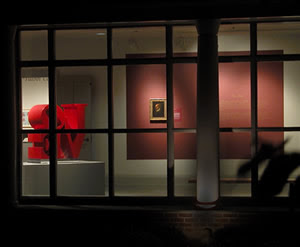Trip to the Academy Art Museum, Easton, MD

Drove down to the Eastern Shore of Maryland on Thursday. You cross the high suspended bridge over the Chesapeake Bay and descend into another world from the Washington-Baltimore sprawl. It's rural and flat and perfect for agriculture, which they do there big time.
I was headed to the town of Easton which boasts the Academy Art Museum, an impressive institution I've watched grow since I first started visiting in the early 1970's. Back then it was a community arts center that was starting to acquire the beginnings of a Permanent Collection, but was still rough hewn.
One of the reasons I went was to attend the Annual Member's BBQ and I was able to meet the new Director of the Museum, Erik Neil, PhD. Erik, as the letters after his name imply, is an art historian. He's former Director of the Heckscher Museum of Art on Long Island and prior to that had run the art galleries at Tulane University. Running any nonprofit in a recession is challenging, so I wish Erik and his staff the best in attracting support for this deserving Museum. (Any deep-pocketed readers of this blog should send the Academy Art Museum a check right away. When my own ship comes in I'll give them a least a couple of its lifeboats).
The Museum has an intriguing personality. On the one hand, the Eastern Shore is a real bastion of traditional art. The Museum has a long history of showing and collecting realist painting, and landscape painting in particular. But it also regularly shows work that is thoroughly modernist. This month they're opening a show of the fifty works they received as a gift from the Dorothy and Herbert Vogel Foundation, a largely conceptual batch of work. Brian Young, the AAM's Curator has a special enthusiasm for such art and speaks articulately about its underlying themes. Hopefully he'll be permanently stationed in the galleries to explain it to any confused or bemused visitors during the show.
One of the other things that brought me down to the Museum last week was a little exhibit they have up of landscapes from their Permanent Collection that includes work by Eugene Leake and Henry Coe. Leake painted the oil above titled Young Trees on a Grey Summer Morning from 1974.
Leake was President of the Maryland Institute College of Art and was responsible for hiring me to come from the West Coast to join the faculty at MICA in 1973. He saw in my paintings a kindred spirit to his own, and as he was planning to retire to devote himself to his painting, he must have figured I could help keep the torch burning for his kind of painting at MICA after he was gone. Lord knows, I've been doing my best.
Leake was an unusual artist for the 1960's and '70's as he was devoted to direct observation of the landscape and would usually start and finish his often large oils out in the field. In the '70's I was 100% on the same path and to this day have a deep respect for that plein air tradition of painting. This particular Leake oil highlights some of Leake's strengths with brushwork. He creates four sphere-like trees in a row along a roadside and varies their color very little. Yet the closer two have a completely different character than the farther trees as he leaves them progressively more empty of foliage. The closest tree seems more made of empty spaces than leaves and still manages a noble solidity. That's hard to do.
My old friend the painter Henry Coe was one of the very first Directors of the AAM back in its infancy when it was called the Easton Academy of Art. His oil Lengthening Shadows from 1985 is a favorite of mine. Coe shows us his ability to establish very different intensities of shadows. Look at how sharp the shadow is in the foreground as the road plunges back into the space of the field. In comparison, the larger nearly horizontal shadow that stretches the entire width of the painting is just a touch lighter and more translucent. That selectivity is the stuff of strong painting. Also notice how the higher of the two clouds runs across the painting's surface exactly parallel to the top slightly diagonal edge of our big shadow on the field. It beautifully knits together sky and land.
Though it is a very modestly sized operation, the AAM is one of the very best conversions of an aging facility into a state of the art museum I've ever seen. Architecturally the building is a real beauty.
There is something undeniably fresh about a museum like this. Visiting such a place gives the viewer a chance to savor just a few dozen pieces of art and leave wanting to see more. I know there's a place for the National Gallery of Art and the Metropolitan Museum of Art, but bang-for-your-buck-wise, the smaller places can pack quite a punch. The AAMis always a fun visit and is worthy of our support.




